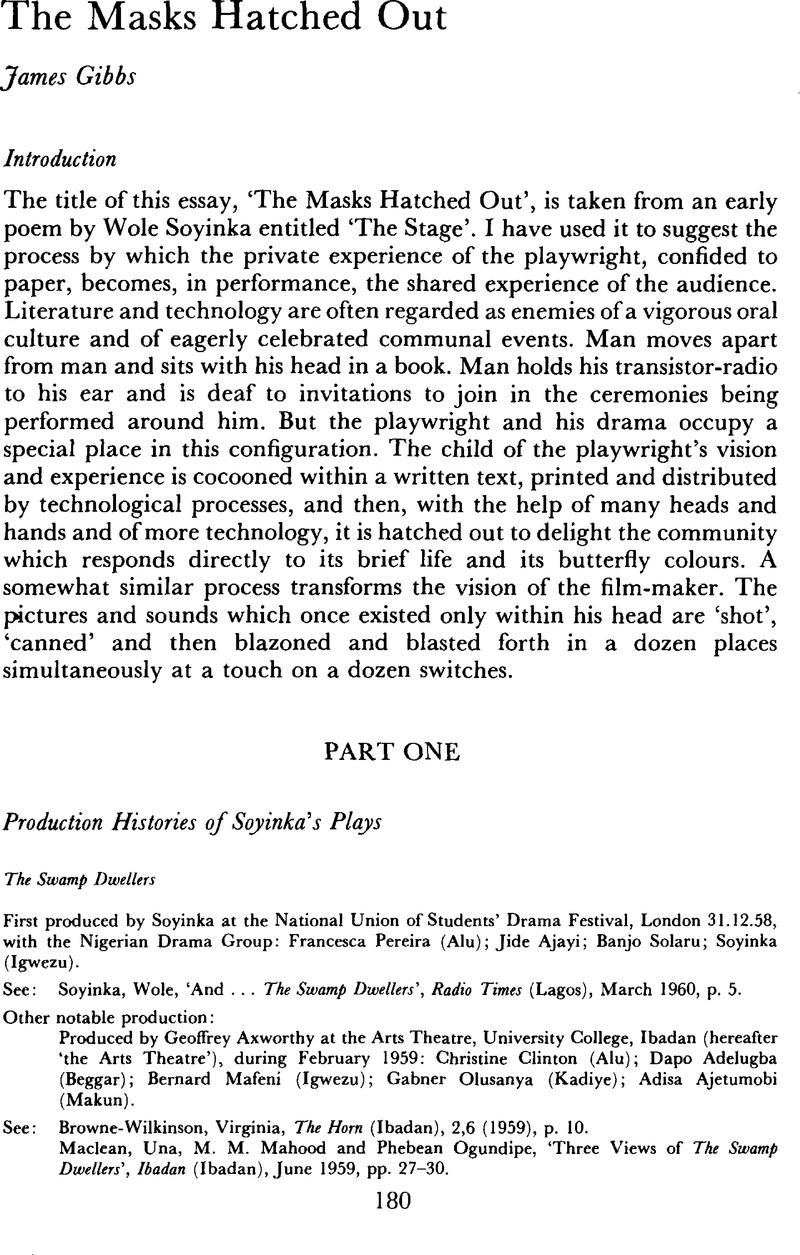Article contents
The Masks Hatched Out
Published online by Cambridge University Press: 23 January 2009
Abstract

- Type
- Articles
- Information
- Copyright
- Copyright © International Federation for Theatre Research 1982
References
Notes
1. Soyinka, Wole, quoted in In Person: Achebe, Awoonor and Soyinka, edited by Morrel, Karen L., Seattle, 1975, p. 103.Google Scholar
2. Alawada: ‘Yoruba comic theatre’: àwàdà = joke; aláàwàdà = a joker, ‘teller of humorous stories’. The term is gaining new dimensions as the comic theatre troupes develop new styles.
3. Ogunbiyi, Yemi, ‘Soyinka Through Brecht: A study of Opera Wonyosi’, Seminar paper, Department of African Languages and Literatures, University of Ife, 01 1979, pp. 16–17.Google Scholar
4. Browne-Wilkinson, Virginia, The Horn (Ibadan), 2, 6 (1959), p. 10.Google Scholar
5. Soyinka, Wole, ‘And … The Swamp Dwellers’, The Radio Times (Lagos), 03 1960, p. 5.Google Scholar
6. Remi Adeleye, creator of the role of Eshuoro, translated the name as meaning ‘Eshu who lives in the Oro tree’. Others have linked the trickster god of fate with orò (a cult) and oró (poison). But these suggestions are just the beginning of the debate. ‘Ifada’ may not be a Yoruba name, but it may be and could mean ‘Ifa has betrayed me’ or ‘a worthless thing’.
7. Morrel, , 1975, p. 94.Google Scholar
8. The ‘dramatis personae’ of The Invention include some whites and a black bishop but most of the characters were a ‘pasty grey’ – racially indeterminate.
9. The Road incidentally was billed in 1965 as a forthcoming production of the 1960 Masks and so, it seems, it was not written for the London production.
10. Soyinka directed The Biko Inquest (by Jon Blair and Norman Fenton) in December 1978 and took it to New York in 1980.
11. ‘Tale of Two Cultures’, Topic (Washington), No. 127, p. 33Google Scholar. Hereafter referred to as Topic.
12. Topic, p. 34.
13. Topic, p. 33.
14. Geoffrey Axworthy, personal communication.
15. Browne-Wilkinson, 1959.
16. ‘Sheer Ingenuity of Soyinka's Plot’, The Times (London), 13.12.66, p. 6.Google ScholarPubMed
17. Agaraogun, Olu, ‘Wole Soyinka’, Spear (Lagos), 05 1966, p. 18.Google Scholar
18. Soyinka, Wole, ‘Technology and the Artist’, Malawi News (Blantyre), 30.12.77, p. 20.Google Scholar
19. See Dundun, Ann, ‘Soyinkan Aesthetics in Culture in Transition’. Paper presented at the 1st Annual Literature Conference,Ibadan, 1976.Google Scholar
20. The Negro Ensemble production in New York had stressed the Kongi-Banda links; Soyinka suggested a new parallel by his performance.
21. Soyinka, Wole, Letter, Transition (Kampala), 40 (12 1971), p. 8.Google Scholar
22. Morrel, , 1975, p. 125Google Scholar. For a critical review which may convey some of Soyinka's grounds for disapproval, see Siber, Irwin, The Guardian (London) 26.5.71, p. 13.Google Scholar
23. Before the Blackout, Preface.
24. Before the Blackout, p. 58.
25. David Rubadiri, personal communication.
26. Morrel, , 1975, p. 106.Google Scholar
27. Soyinka, Wole, African Writers Talking, edited by Duerden, Dennis and Cosmo-Pieterse, , London, 1972, p. 174.Google Scholar
28. Lewis, Peter, ‘Funny Satire’, Daily Mail (London), 29.6.66Google Scholar. Day-Lewis, Sean, ‘Brother Jero Full of Vitality’, Daily Telegraph (London), 29.6.66.Google Scholar
29. Collings, Rex, ‘Wole Soyinka: A Personal View’, The New Statesman (London), 76 (20.12.68), p. 879.Google Scholar
30. Ogunbiyi, , 1979, p. 17.Google Scholar
31. Morrel, , 1972, p. 127.Google Scholar
32. Death and the King's Horseman, ‘Author's Note’.
33. Collected Plays, 1, pp. 70–2Google Scholar with pp. 75–7.
34. Osofisan, Femi, ‘Soyinka in Paris’, West Africa (London), 21.7.72, p. 935Google Scholar. A video tape has been made in the Workshop Theatre, University of Leeds, which raises and resolves some of the production problems of A Dance.
35. Fearn, Marianne, Modern Drama of Africa: Form and Content: A Study of Four Playwrights, Unpublished Ph.D. Thesis, Northwestern University, 1974, p. 229.Google Scholar
36. Morrel, , 1975, pp. 81–93.Google Scholar
37. Before the Blackout, p. 59.
38. Personal communication, G. A. Wilson.
39. I am very grateful to Dapo Adelugba for discussing the issue with me, and for filling in a number of gaps in the production history section.
40. Jones, Eldred Durosimi, ‘Editorial’, African Literature Today (London), 8 (1976), xii.Google Scholar
41. Moore, Gerald, Wole Soyinka, 2nd edition. London, 1978, p. 27.Google Scholar
42. Topic, p. 34.
43. I have omitted reference to Francophone Africa, although the production histories of The Lion and the Jewel and Brother Jero show that there has been a limited interest in productions of these plays in French. The impact of those productions has, I suspect, been very limited.
- 1
- Cited by




